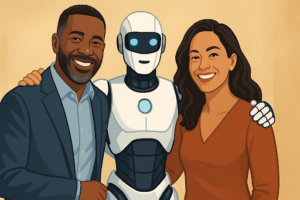Alive and Local: A Strategy to Combat Those A.I. Voices Across the Street

How to leverage pre-existing audience perceptions to make it costly for competitors who jump on the A.I. train simply to save a buck and without concern for quality. Why is it important to make ‘em pay? Because we’ll all pay for poorly executed Robot Radio.
Mike O’Connor & Carolyn Gilbert
Cost-conscious radio executives have begun eyeing AI voices as potential replacements for human air talent, especially in less valuable dayparts or where spoken word content takes a back seat to music. The state of the art has come a long way, and advanced algorithms are approaching the point where it can be hard to tell the difference between a bot and a human.
Some are taking the view that bots could never replace human talent, and that the audience would never accept AI radio hosts. We heard a similar argument in the early 2000s when voice tracking swept across the industry. I remember the mostly internal pushback and the negative press articles, but here we are two decades later, and pre-recorded shows, many piped in from outside local markets, are now the rule rather than the exception. With PUMM declining at a steady annual clip of around 8%, you can be sure the push for AI talent will feature prominently in the cost-benefit discussion at the corporate radio budget table as we head into 2024.
The audience perception, in fact, may already be ahead of the coming AI reality. In our recent Moneyball for Radio video series on nuvoodoo.com/webinars, we shared results from our 22nd Ratings Prospect Study and found that more than a quarter of our total sample of better than 2,500 14-54 year–old respondents think that most of the personalities currently on the radio are AI voices. Moreover, when we focus on the roughly 500 in our study who model as likely to participate in the Nielsen ratings, that perception jumps to nearly four in ten. That’s almost half the people responsible for giving radio its monthly report card today!

Well-trained AI voices don’t get tired, take breaks, or have off days. AI voices can minimize the risk of human error or emotion in live broadcasts, such as factual inaccuracies or inappropriate comments. Plus, you don’t need to pay the salaries required by human DJs, provide benefits, settle HR issues, or cover expenses related to employment, like payroll tax or 401k matches. In fact, AI voices can operate 24/7 without the need for sleep or rest, making it possible to run radio stations continuously and cater to a local, or even global audience without interruption. Advanced learning algorithms have come a long way in making bots sound natural, somewhat overcoming problems like lack of expressiveness, poor pronunciation, or putting the wrong em-PHA-sis on certain words. In fact, the state of the art allows particularly talented humans to “train” their voices in AI, assuring a career that can extend decades beyond their natural shelf-life. So, what’s not to like?
One of the primary drawbacks is the absence of human connection. Live (or even tracked) air talent can engage with their audience, take requests, and provide a more personalized experience, which AI voices struggle to replicate. While AI voices have improved significantly, they may still struggle with nuances of speech, emotional expression, and understanding complex requests or interactions. AI voices are limited in their ability to inject creativity, humor, or spontaneity into broadcasts. Human air talent can adapt to current events, share personal anecdotes, and add personality to their shows.
While these factors can be mitigated with great writing, getting the most out of an AI bot can require rewrite after rewrite to overcome these limitations. Those extra hours add up, putting at risk those on-paper savings that looked so attractive on a budget spreadsheet.
Audiences may resist the transition from human air talent to AI voices due to the emotional attachment they have to their favorite hosts. Replacing humans with AI in broadcasting jobs can lead to concerns about job displacement, so there are PR implications of replacing human talent with automation. Plus, local advertisers still covet the show business surrounding a live remote or talent appearance.
In our recent study, we asked respondents to consider a station where talent is adjunct to music and to rate their emotional response to various levels of automation, from none-at-all to fully AI-hosted.

While good feelings dip dramatically from the 58 percent in our sample who rate “Live & Local” positively, AI bots score better at a 26% positive rating compared to either pre-recorded or piped-in voice-tracked broadcasts, rated each at 23% positive.
Negatives stair-step higher at each level of automation that gets further away from live, local… and human, with AI voices reaching a negative peak of 35% of the sample. But those kinds of scores aren’t all that different than non-local, simulated live broadcasts. Given the fact that voice-tracking is going nowhere, are the AI-associated negatives likely to dissuade managers from riding the train to expense-saving nirvana? Not a chance.
But there’s nothing worse for radio than badly done AI. Piling on writing and AI-rendering chores to an already overloaded staff is a recipe for cultivating negative reputational baggage (not to mention a scathing Robots on Radio episode of South Park). For a station or group committed to cultivating an image for live & local talent, if for no other reason than as a local-direct sales strategy, our study most certainly reveals some exploitable negatives for marketing and station imaging campaigns.
But audience members will hardly notice well-done AI unless an issue is made of it. Stations committed to remaining live and local can cultivate a competitive advantage simply by exploiting the negatives in a cross-town rival committed to cost-savings. We may not be able to stop AI, but for those of us interested in preserving jobs and maintaining add-value for advertisers still spending well north of 13 billion dollars in over-the-air spots annually, there is a path that will make it more difficult on operators who settle for AI-hosted dayparts without any concern for quality.
By holding Robot Radio operators accountable, we may at the very least pave a transition from jobs that require strong voice talent to those that demand strong writing skills. Even the best chat GPT-generated content requires human curation. As a result, the station might not only profit from NuVoodoo’s AI pushback playbook. But we might incorporate technology that makes radio materially better.
NuVoodoo AI Pushback Playbook
Human Connection: Highlight the authenticity that live talent brings to the radio experience. Promote your station as a place where listeners can connect with real people who understand and cater to their local community’s interests and preferences.
Showcase Localism: Emphasize your station’s commitment to the local community. Feature local news, events, and interviews with community members and organizations. Position your station as the go-to source for local information and engagement.
Interactive Shows: Create interactive shows that encourage listener participation. Host contests, take live calls, read listener messages, and engage with your audience in real time. This level of interactivity is challenging for AI voices to replicate convincingly.
Personalization: Train your live talent to personalize their content and interactions with listeners. Encourage hosts to mention local landmarks, share personal anecdotes, and create a relatable and personable on-air presence.
Specialized Knowledge: Showcase the expertise and knowledge of your live talent. If you have hosts who are experts in specific fields or genres, leverage their expertise to provide unique insights and content that AI voices cannot match.
Behind-the-Scenes Content: Offer behind-the-scenes content to give listeners a glimpse of the inner workings of your station. This can include interviews with your live hosts, studio tours, and insights into the creative process.
Transparency: Be transparent about the use of AI voices by your competitors, emphasizing the value of human hosts in providing a more authentic and engaging listening experience.
Promote Community Engagement: Encourage your live talent to actively engage with the community outside of the radio station. Attend local events, partner with local businesses, and participate in community initiatives to build stronger connections with your audience. “Feature talent donating to the blood bank. Post videos that remind the audience of “Bots Can’t Give Blood” at your station blood drive.
Marketing and Promotion: Use marketing campaigns and social media to promote the uniqueness of your live talent. Showcase their personalities, backgrounds, and the value they bring to your station.
Listener Testimonials: Collect and share listener testimonials and stories about their positive experiences with your station and live hosts. Genuine endorsements from satisfied listeners can be persuasive.
Adapt and Innovate: Stay open to technological advancements and innovation in broadcasting. While emphasizing the human touch, consider incorporating AI and automation for tasks that enhance the listener experience without replacing live talent. Or the very least, be honest about why and where you use AI voices.
A.I. Voice Bot Re-Positioning & Marketing Message Idea-Starters to Help Combat Those Cross-Town Robot Rivals
“Real Voices, Real Connections: We’re not robots on the radio. We’re as inspired by the music we play as you are”
“Experience the Difference: At [Your Station], we believe radio is all about real people sharing real stories. No AI voices here, just the authenticity of our local personalities.”
“We’re More Than Just Music: Unlike the automated competition, our live hosts are here to entertain, inform, and connect with you on a personal level.”
“Local Beats Robot: Robots across the street can’t capture the heartbeat of our community like our live hosts can. Join us for a truly local experience.”
“Robots Don’t Feel the Music: Our live DJs bring passion, emotion, and soul to every song. Feel the difference at [Your Station].”
“Where Personality Meets Music: We’re not in the business of robots; we’re in the business of creating connections. Join us for a more personal radio experience.”
“Robots Can’t Take Requests: Want to hear your favorite song? Call us, chat with our live hosts, and make your request a reality.”
“The Heart of [Your City]: We live, breathe, and broadcast from right here in [Your City]. Robots can’t replicate that local love…and they can’t breathe either!”
“We’re Not Programmed: While the competition may be automated, we’re unscripted, unrehearsed, and unforgettable. Tune in and let the magic of live radio sweep you away.”
“AI Can’t Capture Your Voice: We value your input and conversation. Join us, where your voice matters and our hosts are alive and local.”
“Our live hosts craft radio moments you won’t find in an algorithm.”
“Why Settle for Robo-Radio? Elevate your listening experience with real people who care about your day and your music”




